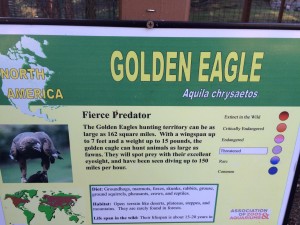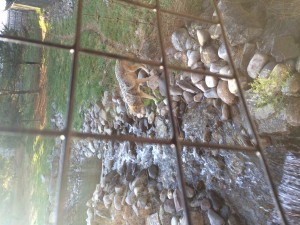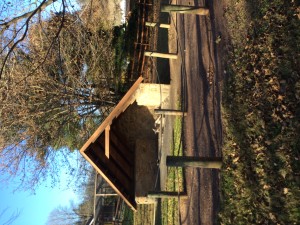This past Sunday I went on the Hawk Mountain and Cabela’s trip by myself. As I was preparing to leave around midday I could tell I was not going to see very many raptors. The air was warm and the conditions were not prime for migration. I didn’t let this discourage me though, I dressed in layers and started my drive to Hawk Mountain. In the early afternoon I arrived at the Hawk Mountain Visitor Center, and after going in to pay, I decided to leave the center and start my hike and try to explore the various lookouts. I only had until dusk to see as much as possible, so that was my plan.
The first thing I noticed while starting my trek was the variety of age groups and how they were prepared for their own experience. There were many parents with their young children, elderly couples with binoculars, teenagers, and an assortment of others as well. It was a bit of a surprise to me how few people I saw with binoculars, but I thought to myself that this was the initial part of the trail maybe I’d see more as I continued on. I wasn’t in any position to judge because I didn’t own a pair of binoculars; I had hit the trails with just my field notebook, a pen, the reading and trip over view, and a trail guide.
As I continued the hike I was starting to get a little disappointed. The further in I went the more Hawk Mountain seemed like just a tourist destination, where I had been expecting it to be a more secluded entity where only interested bird watchers would go. I started to try to avoid the other people on the mountain. After about five minutes of hiking I came across the Bald Lookout and, seeing it was mostly empty, decided it would be my first real stop. Climbing over the scattered rocks I got myself to the edge and sat down. I was there for approximately twenty to thirty minutes, simply enjoying the silence and the view. Around this time a group of four or five teenagers showed up and it became clear within seconds it was time for me to find a new location. The first thing out of the mouths of the group was, “take a picture of us on this rock.” They were loud and slightly obnoxious. Realizing this group was going to subtract from my appreciation of the lookout I left having not seen a single bird, let alone any raptors.
After leaving the Bald Lookout I continued up the trail towards the fork separating the Sunset Overlook from the North Lookout. I was becoming even more discouraged the further I went up. I seemed to only see families and younger individuals ascending the mountain. The people descending were elderly couples, folks with binoculars, general people who appeared to fit the mold I was expecting Hawk Mountain to be filled with. When I finally reached the fork in the trail I took the path towards the North Lookout. From my observations I had seen less of the tourist crowd headed in that direction, it was my hope that there would be less people on this trail. Shortly after heading to the North Lookout I came upon to Kettle View, and seeing it empty, I once again decided to stop.
Just like I had at Bald Lookout, I climbed out as far as I could and still be able to sit comfortably. I honestly couldn’t be sure how long I sat at Kettle View, but I did not see a single raptor. I did not mind though. The size and location of Kettle View, the view from this lookout, and the general traffic at this point started to seem more like my expectations. It was a smaller overlook that came across as more secluded. As I sat on a large rock I started to hear a lot of noise from rustling leaves. I took my eyes off the view and started to look around, wondering if it was someone approaching or an animal nearby. Soon enough the animal emerged; it was a tiny little field mouse scuttling around. This siting caused my mind to wander. I was curious if this mouse would be a raptor’s breakfast or dinner in one of the upcoming days. It continued to appear and disappear during the duration of my time at Kettle View.
Once I tired of Kettle View, I moved on to the North Lookout. I initially was discouraged by the amount of people I saw from a distance but as I got closer I realized many of the people were staff of Hawk Mountain. The few people there who weren’t employees of the mountain were mostly quiet, observing the skies. There were a few children with their parents who were being noisy and disruptive but the parents attempted to keep them in line. Although I stayed at this look out until nearly 4 P.M. the only birds I managed to witness was a small gathering of what I assumed were finches. I could not tell from the distance they were at, but I overheard the employees talking about finches a few minutes before I had seen them. It was interesting watching people interact at the North Lookout. For most of the day I didn’t notice people in different groups interacting, with the exception of passersby saying hello to each other, they mostly kept to themselves. At the North Lookout though I noticed visitors interacting with the mountain employees, asking questions and having conversations about what they are seeing or missing. The North Lookout had been the most respectful which helped to eliminate some of the tourist attraction feel Hawk Mountain had been emanating the whole day. Once satisfied with my exploration of the mountain, I went back to observe the Visitor Center.
The visitor center I think was a good representative of Hawk Mountain itself. On the one hand it was extremely informative and appeared to only care about informing visitors of the various raptors that could be seen from different lookout spots. At the same time it gave off this very tourist attraction feel. On the opposite side of the center, where the store was, they were selling stuffed animals, clothing, children’s books, and bird feeders. Many of these things, I noticed, are contributors to anthropomorphism. I couldn’t help but wonder what Sterba would have thought about it. I was also curious to know how many young people actually read any of the facts in the visitor center. If I was a child I know I would have instantly gone over to the store to explore before thinking about looking at the information in the displays. While I believe that Hawk Mountain portrayed nature as a place to be observed and appreciated, I feel it subtracted from itself by drawing in people who could be seen as “the masses,” individuals not there to appreciate nature as we have studied it in class but to gawk at as if it were a picture in a museum.
As Rachel Carson points out in Silent Spring, specifically her chapter And No Bird Sings, birds have a significant impact on the ecosystem they live in. In the chapter she explains that, in the attempt to save the elms, we are actually killing them. By spraying insecticide, we are killing and poisoning the insects that are eat by various bird species. This, in turn, is poisoning and killing the various birds in the region that rely on the insects as a food source. Once the birds start dying off, the insects, that are mostly surviving the various chemicals, are still there to transfer diseases from tree to tree. Carson explains that, although it isn’t the as explicit with other species, eagles and hawks that migrate along the coast are starting to die off from DDT and other insecticides poisoning them. She mentions that counters that track the population of various species have noted smaller numbers of various birds of prey using Hawk Mountain as an example of a site where the numbers of reported sightings has decreased. These decreased sightings also mean a less healthy ecosystem. Birds of prey in an area is a sign of a balanced ecosystem. If they are in a particular area it is a sign there is flourishing life for them to feed on. This is not to say if there is no raptors in the area there is no food just that the environment isn’t necessarily balanced. If no predators live in an area than there is no population control of its prey. Without any form of population control ecosystems are doomed to fail.
Cabela’s was a completely different environment than Hawk Mountain. It portrayed a different view of nature. At Hawk Mountain humans were separate from what was around them, viewing it as an outsider in a respectful manner. On the other hand Cabela’s portrayed a version of nature where humans and nature interacted but not with mutual respect. Although I do believe that a decent amount of Cabela’s loyal customer base has a respect for nature, the store paints the picture of humans trying to tame it as opposed to work with it. Cabela’s customer base tend to be hunters and fishermen and women, because of this many of the things the store sells and displays revolve around these two hobbies. These activities have the inherent nature, in today’s society, to be a controlling activity. In a world where one doesn’t need to hunt or fish for food, the respect behind the activity is almost all but lost. A prime example of this is the various animals that had been stuffed and displayed around the store. They were stuffed and posed to paint the portrait the store wanted. A taxidermist controlled the once wild creature that the hunters brought to them.
One of my favorite things about Cabela’s was how they combined the living fish with the mounted and stuffed wildlife. Although fish taxidermy exists, it is extremely difficult. Plus when a taxidermist mounts a fish, it typically mounted on a wall which would not give the same feel for the countless customers taking pictures with the mounted displays as having live fish swimming in a pond full of stuffed ducks floating around. I thought it was interesting how the store tried to compensate for not having mounted fish by having the aquarium. It allows them to appeal to their fisherman customer base. It was definitely a funny, but understandable, aspect of the store’s mountain display.
Walking around the clothing section of Cabela’s was interesting as well. All their clothing brands were outdoors brands such as Carhartt, North Face, Under Armor, Timberland, Cabela’s brand, Wrangler, Columbia, etc. This was expected, what made it interesting was how the target demographic was reached. All the men and boys were typical camouflage, the women’s clothing, however, all had a conventional “girl color” added to it. Even the baby clothes had this motif. I observed the “boys” baby jumper was clad in camouflage while the “girls” jumper was purple and had sparkly lettering on it. The store definitely was feeding into a stereotypical notion of gender roles.
Another interesting thing I noticed was the holiday themed gifts Cabela had on display. Because it is the holiday season there were many Christmas themed gifts throughout the store. Originally I noticed prepacked snacks for hunters to eat while they are in their blinds for hours. This is an understandable gift. I also noticed displays for field kits that allowed you to make quick jerky of various animals you have just hunted. Again this didn’t take me too much by surprise. The gift display that stopped me in my tracks, do a double take, and walk back to get another look at it was pork skin candy canes. I was in shock. I am very aware people enjoy eating pork skin and pork rinds but I was not expecting someone to make them into candy canes. Thinking about it now I am curious if they have a peppermint flavor like typical candy canes do? The candy canes followed the normal white, or in this case tan, and red swirled. I couldn’t help but wonder how my uncle would respond to me buying him any of these Christmas gifts.
For a while I have debated with myself which place I liked better. I am not sure if I have an answer to that question even now. I will say that I have a little more respect for Cabela’s than Hawk Mountain. The reasoning behind this is how honest I feel Cabela’s presents itself in comparison to Hawk Mountain. My experience was different than everyone else’s for a multitude of reasons including, but not limited to, the time of day I went, the group versus solo dynamic, the weather, etc. This may be the reason I have this opinion. I knew going to Cabela’s what I was getting myself into. I have actually driven past that specific Cabela’s every summer for nearly five years now, possibly even longer, when I drive home from my family’s annual trip to Knoebels Campground. Having relatives who hunt and shop at Cabela’s I had a general idea of the environment and the people that were going to be in the store. It was great watching people take pictures with the mounted animals and watch the fish swim around. I felt Cabela’s was very true to itself, almost to the point of being satirical although it obviously is not.
Hawk Mountain, however, gave me the impression that it did not know fully what it was trying to be. It came across as both a tourist attraction and a museum. I know these two things do not have to be mutually exclusive, but it seems counter-intuitive. For me, my favorite part of Hawk Mountain was sitting on a ledge, by myself, and observing the skies. It was a reflective experience and made enjoyable through the silence and lake of disturbances. By being a tourist site, I feel that experience is detracted from. Having families with loud little kids or noisy teenagers around was disruptive. It subtracted from my enjoyment. Perhaps I am getting this impression because I wasn’t expecting Hawk Mountain to give me that feel. Unlike with Cabela’s, I didn’t know what I was getting myself into. I had expectations of a quiet, quaint environment. The only people I expected to be around were the truly dedicated raptor watchers. With that said, I thoroughly enjoyed Hawk Mountain and would like to go again on a day where the weather is more beneficial to seeing birds of prey and to give it another chance to be the place I expected it to be.
![IMG_0669[1]](http://sites.lafayette.edu/evst254-fa15/files/2015/11/IMG_06691-150x150.jpg)
![IMG_0662[1]](http://sites.lafayette.edu/evst254-fa15/files/2015/11/IMG_06621-150x150.jpg)
![IMG_0691[1]](http://sites.lafayette.edu/evst254-fa15/files/2015/11/IMG_06911-150x150.jpg)

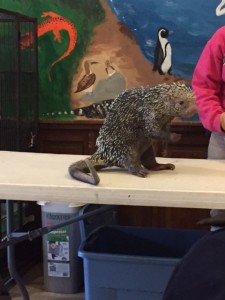
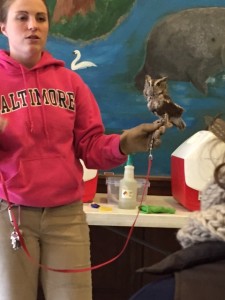
![IMG_0669[1]](http://sites.lafayette.edu/evst254-fa15/files/2015/11/IMG_06691-150x150.jpg)
![IMG_0662[1]](http://sites.lafayette.edu/evst254-fa15/files/2015/11/IMG_06621-150x150.jpg)
![IMG_0691[1]](http://sites.lafayette.edu/evst254-fa15/files/2015/11/IMG_06911-150x150.jpg)
